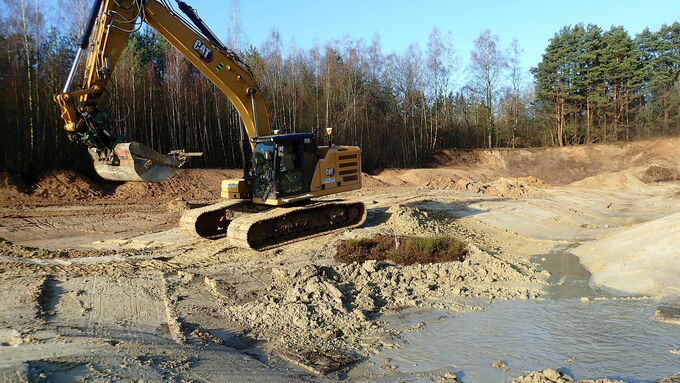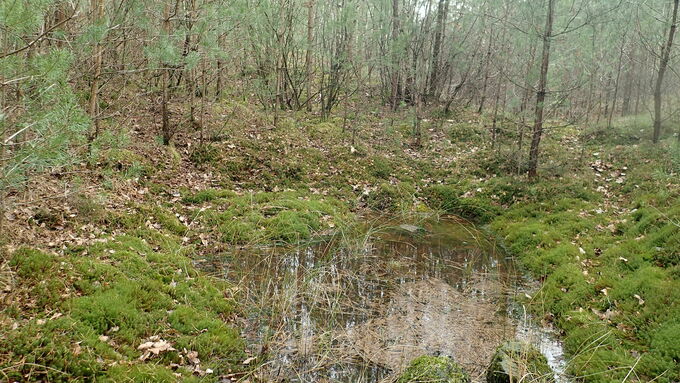Small waterbodies were created through the targeted use of dredging. © Leonie Braasch, NLWKN
download picturemain content
Project of the month
#2/2023 A big transformation
From a dark pit to a light paradise for the natterjack toad
In the south of the Emsland region, outside of protected areas, there is a former sandpit which had disappeared over time under a dense young pine-birch forest. From 2018 to 2021, adult natterjack toads (Bufo calamita) and tadpoles were still occasionally recorded here, but the sand pit increasingly lost its function as a habitat for the species. Hardly any sunlight fell on the silted small waterbodies which were hidden in the undergrowth between willows and overaged heather.
In order to restore this actually ideal habitat for the natterjack toad, the Lower Nature Conservation Authority of the Emsland district had proposed the sandpit for an action within the third project phase of LIFE IP. The focus species sand lizard (Lacerta agilis) also occurs in this area. As part of a CEF measure (early compensation measure) for the replacement of various locks on the Dortmund-Ems canal, additional sand lizards had been relocated to the neighbouring area of the sandpit. This area had previously been prepared as a habitat for the sand lizard, for example by creating deadwood piles and stone bars. The sand lizard can thus also benefit from an upgrading of the sandpit with plenty of soil for egg deposition. In return, the sand lizard area can also serve as additional terrestrial habitat for the natterjack toad.
The private owner was convinced of a comprehensive change on his property and also the municipality of Emsbüren as the second owner agreed to the clearing of a marginal strip in the sandpit. In January 2023, the action started and a large chain excavator rolled into the pit. Its task was, in the first step, to pinch off the woody plants over an area of about 1.4 hectares and bring them out of the sand pit. The next step was to strip off the top layer of soil and get out the root stumps. The terrain was very uneven, however, so that no vehicle for transport could be used. Therefore, the excavator pushed the material to the edge of the brim and milled it once more to prevent another budding. A few small, still well-preserved areas of heath on the tops of the terrain were left out during the work.
The hibernation period of the natterjack toad was also taken into account: with the help of existing root stumps and branches, the excavator built eight south-facing winter quarters, the northern side of which was covered with sand again. The focus was also on the creation of small waterbodies. The excavator reworked the existing depressions and modelled shallow water zones. Areas with clay subsoil, which hold water better than pure sand, were particularly suitable. A variety of different waterbodies is always advantageous for the natterjack toad. As a finishing touch, a few small waterbodies with the size of an excavator shovel were created which may quickly fill up and warm up after a rain shower. A total of 23 waterbodies were created. The works were accompanied by the UNB and an expert on amphibian measures.
For the coming spring, the sandpit with the large open sand area and the diverse spawning opportunities now offers an attractive habitat for the natterjack toad again. The sand lizards will probably wait until the sandpit is overgrown with more vegetation again and only then colonise the area. In the past, the sandpit was also a suitable habitat for night moths. In 2006/2007, more than 40 different species were registered here, including the ringed carpet (Cleora cinctaria, Red List 3). After completion of the action, more insects and other open-land-loving species can now also find their way back into the sandpit.





